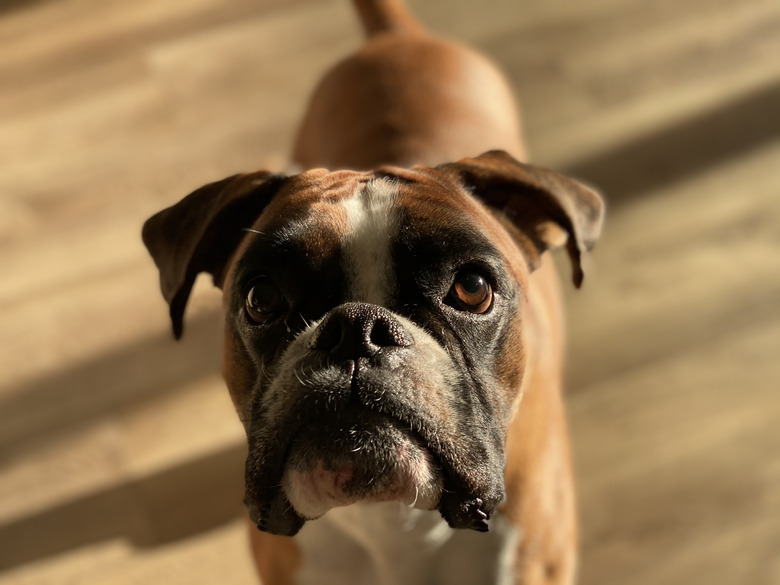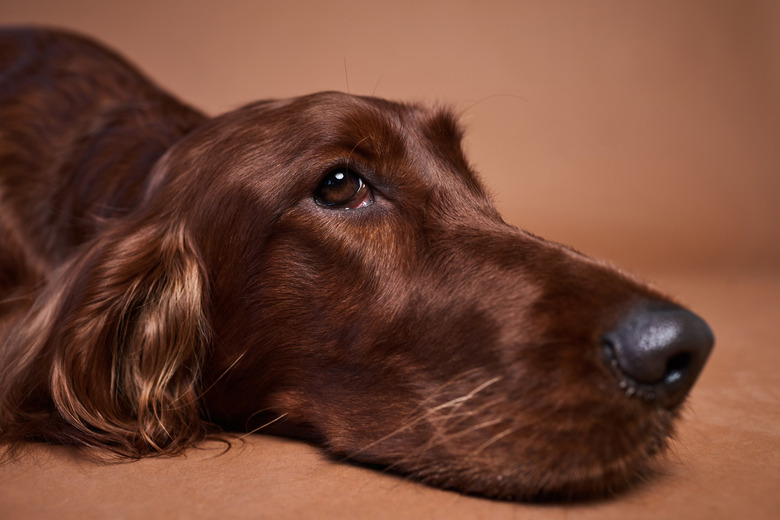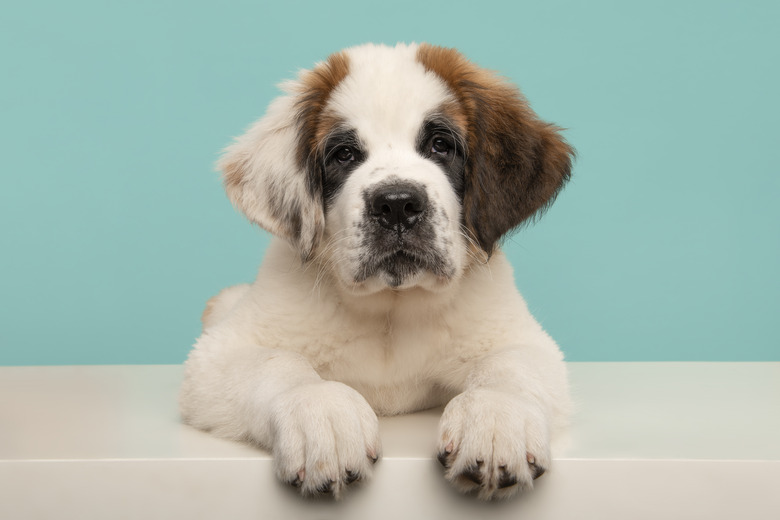What Is Bloat In Dogs And Why Is It So Dangerous?
Bloat or gastric dilatation is when a dog's stomach becomes abnormally distended. This can stem from gas or large amounts of food. Bloat can occur for any reason and in some situations, it resolves on its own. But in certain dogs, bloat can progress to gastric dilatation-volvulus or GDV. With GDV, the bloated stomach twists by flipping on itself — which is a life-threatening condition for dogs.
Why are bloat and GDV dangerous?
Why are bloat and GDV dangerous?
One reason bloat is dangerous is because it can suddenly and unpredictably turn into gastric dilation-volvulus. GDV is dangerous because of the volvulus — the obstruction caused by stomach twisting. This prevents the gastric contents from moving out. It also prevents blood from flowing beyond (and into) the affected tissues and the stomach can start to die. The spleen can also become twisted.
In addition to this, the twisted and distended stomach pushes up against major blood vessels in the abdomen. This reduces the amount of blood making it back to the heart, which compromises the entire canine body's blood circulation. Cells in other organs, like the liver and kidneys, can die due to the lack of blood supply. The general lack of blood flow will cause toxins to accumulate in a dog's body.
The dilated stomach will also push against the diaphragm, making it more difficult for a dog to breathe. In some cases, the stomach wall may rupture.
Symptoms of GDV and bloat in dogs
Symptoms of GDV and bloat in dogs
The symptoms of bloat and GDV are similar and they can happen suddenly. You won't be able to tell which one your dog has just by looking at them. This is another reason bloat and GDV are dangerous.
The most common signs are:
- Panting
- Restlessness
- Unable to get comfortable, such as while lying down
- Standing and stretching
- Excessive drooling (or if your pup is already a drooler, drooling more than usual)
- Distended belly
- Retching but nothing coming up
Dogs with GDV may also have:
- Sudden weakness or staggering
- Collapsing
Be aware though, that some dogs can still be perky and alert when they have bloat or even GDV. So if your dog has any of the above signs, take them to a veterinarian immediately. If your regular clinic is closed because it's after-hours or a holiday, your dog needs to go to an emergency animal hospital for immediate veterinary care.
For the best chance of survival, your pet needs to be seen within minutes to hours of when their symptoms first begin.
Risk factors for GDV and bloat in dogs
Risk factors for GDV and bloat in dogs
Though bloat and GDV are not fully understood, there is an association with:
- Large and/or giant breed dogs
- Older dogs, especially those who are over the age of 7 years
- Deep-chested breeds
- Male dogs
- Fearful, anxious, or aggressive dogs
- Underweight dogs
- Dogs that have a family history of GDV
- Dogs eating large amounts of dog food at once (e.g. a single and large meal)
- Dogs Eating rapidly
- Eating dry foods that have oils or animal fats within the first four ingredients
- Eating dry dog foods that contain citric acid
- Eating dry food that has been moistened (such as with water) before feeding
- Drinking large amounts of water before or after exercise
- Exercising an hour before eating and two hours after eating
German shepherds, Great Danes, dobermans, Irish setters, Gordon setters, standard poodles, boxers, St. Bernards, and Weimaraners are at-high-risk breeds. However, any dog can bloat and potentially get GDV — including small breeds.
Diagnosing gastric dilatation-volvulus and deciphering it from bloat
Diagnosing gastric dilatation-volvulus and deciphering it from bloat
Exam findings and tests will help your veterinarian determine if your dog just has bloat or if they now also have GDV. On a physical exam, dogs with GDV won't just have a distended stomach. They will also have an elevated heart rate, elevated respiratory rate, low body temperature, a weak pulse, and pale gums. An electrocardiogram (ECG) may also show an arrhythmia.
The classic method of diagnosing GDV is with x-rays of the dog's abdomen. When your dog is laid on their right side and x-rayed, the stomach will appear as two gas bubbles. It will be separated by a band of its own twisted tissue. However, a bloated stomach that's not twisted appears as just one large bubble.
Bloodwork on a dog with GDV may show elevated kidney and liver values. Electrolytes can also be out of the normal range. The complete blood count (which provides values for red blood cells and white blood cells) may have shifted — which reflects the stress the dog's body is under.
Treating bloat versus treating gastric dilatation-volvulus
Treating bloat versus treating gastric dilatation-volvulus
Simple bloat without volvulus may be addressed with IV fluids and medications. However, a dog with GDV requires surgery. But prior to doing that, the pet will need to be stabilized with intravenous fluids, oxygen, and stomach decompression. Despite the nature of the emergency, anesthetizing a dog who is in shock reduces the chances of a good outcome.
Before surgery, it's critical that the stomach is relieved of pressure from accumulated gas. This helps restore normal circulation. Decompression can be done with a tube that is inserted into your dog's throat and down into the stomach. (This is done with sedation, not anesthesia.) If the tube cannot be passed, a large needle or catheter can be inserted from the outside of the body into the stomach.
After stomach decompression, your dog will undergo surgery to untwist the stomach. The stomach, spleen, and other tissues in the abdomen will be evaluated to determine if additional surgery is needed. Surgery options can include removing part of the stomach wall or removing the spleen if they are no longer viable.
Prevention of bloat and GDV
Prevention of bloat and GDV
While your pet is under anesthesia for GDV surgery, the veterinarian will also perform a surgical procedure called gastropexy. This attaches the stomach to the abdominal wall. A dog can still bloat after this but the stomach won't twist.
If you have a young and healthy, but at-risk breed of dog, prophylactic gastropexy can be done when your pet undergoes their spay or neuter surgery. If they're already spayed or neutered but haven't had preventative gastropexy — to tack their stomach to their body wall, — the procedure can still be done. Some veterinary hospitals even offer this as a minimally invasive, laparoscopic procedure. Since the mortality rate for GDV is 10 to 33%, even with appropriate treatment, prevention is vital.
Other things you can do to prevent bloat and GDV is to use a type of food bowl that slows down eating, known as slow feeder bowls. You should also avoid large meals for your dog. Instead, offer 2 to 3 small meals a day. If your dog is in a kennel while you're at work, don't leave them with large amounts of dry food. A mix of dry and canned food can potentially lower GDV risk. Also, try to avoid having your dog exercise an hour before or two hours after they eat.
The bottom line
The bottom line
You won't be able to tell just by looking at your dog if they have bloat or GDV. With bloat, the stomach becomes distended with gas (or sometimes food.) But with GDV, the bloated stomach suddenly flips on itself, which is a life-threatening condition. If your dog has symptoms of bloat or GDV, take them to a veterinary hospital immediately.



